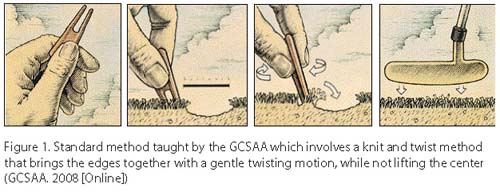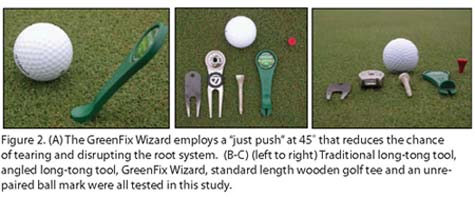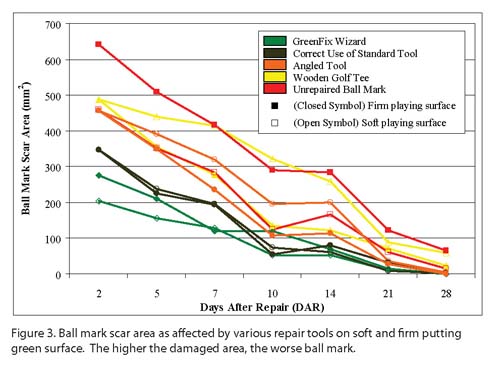Putting green surface smoothness and uniformity is often disrupted by unrepaired ballmarks. These marks can disrupt surface smoothness and increase the potential for weed (e.g. annual bluegrass) encroachment. The traditional method for repairing ballmarks normally employs a metal pronged tool (≈ 1 in or 3 cm), or tee and using a knit and twist method attempting to pull healthy turf from the perimeter into the ball mark (Figure 1). Recently, several new repair tools, such as the GreenFix Wizard (Figure 2), have been introduced with the intent of improving ball mark repair. Many of these tools utilize a simple pushing method and shorter tong lengths (≈ 1/2 in or 1 cm), with less potential for root disruption. The objective of our field-study was to evaluate golf ball mark recovery of two creeping bentgrass areas with contrasting surface firmness and rootzone moisture contents as affected by various ball mark repair tools. Two adjacent locations were prepared to create “firm” (20% moisture, 0-2 in) and “soft” (28% moisture, 0-2 in) study areas. Four ball mark repair tools (Traditional long-tong tool, angled long-tong tool, GreenFix Wizard, standard length wooden golf tee) plus an unrepaired ball mark were evaluated for visual appearance and ball mark recovery for several weeks after ballmarks were naturally created (Figure 2)


- When averaged across all dates for the soft area the GreenFix Wizard and the traditional long-tong tool had the highest ball mark rating values of 7.8 and 7.3, respectively (10=healed, 0=complete injury). The wooden golf tee and unrepaired marks performed the worst with ball mark ratings of 5.4 and 5.0 respectively.
- Ball mark scar areas were largest and most pronounced 2 days after repair (DAR) with scar areas ranging from 205 to 640 mm2. The scars in the unrepaired marks in the soft area were substantially larger 640 vs. 459 mm2 than those in the firm area (Figure 3).
- For both areas the lowest numerical scar area was measured for the GreenFix Wizard, which was not statistically different from the long-tong tool using the traditional method. By comparison using the angled tool and wooden golf tee were not significantly different than leaving the ball mark unrepaired.
- One of the worst performing tools in this study was the traditional wooden golf tee which was similar to an unrepaired mark on all measurement dates in the firm area and six of seven dates in the soft area.
- For optimum recovery, use a traditional tool correctly or consider the use of one of these newer short-tong tools with a pushing method.
For more information refer to the full text of this article on our Research Summary website at www.agry.purdue.edu/turf/report/2007/index.html

Putting green surface smoothness and uniformity is often disrupted by unrepaired ballmarks. These marks can disrupt surface smoothness and increase the potential for weed (e.g. annual bluegrass) encroachment. The traditional method for repairing ballmarks normally employs a metal pronged tool (≈ 1 in or 3 cm), or tee and using a knit and twist method attempting to pull healthy turf from the perimeter into the ball mark (Figure 1). Recently, several new repair tools, such as the GreenFix Wizard (Figure 2), have been introduced with the intent of improving ball mark repair. Many of these tools utilize a simple pushing method and shorter tong lengths (≈ 1/2 in or 1 cm), with less potential for root disruption. The objective of our field-study was to evaluate golf ball mark recovery of two creeping bentgrass areas with contrasting surface firmness and rootzone moisture contents as affected by various ball mark repair tools. Two adjacent locations were prepared to create “firm” (20% moisture, 0-2 in) and “soft” (28% moisture, 0-2 in) study areas. Four ball mark repair tools (Traditional long-tong tool, angled long-tong tool, GreenFix Wizard, standard length wooden golf tee) plus an unrepaired ball mark were evaluated for visual appearance and ball mark recovery for several weeks after ballmarks were naturally created (Figure 2)


- When averaged across all dates for the soft area the GreenFix Wizard and the traditional long-tong tool had the highest ball mark rating values of 7.8 and 7.3, respectively (10=healed, 0=complete injury). The wooden golf tee and unrepaired marks performed the worst with ball mark ratings of 5.4 and 5.0 respectively.
- Ball mark scar areas were largest and most pronounced 2 days after repair (DAR) with scar areas ranging from 205 to 640 mm2. The scars in the unrepaired marks in the soft area were substantially larger 640 vs. 459 mm2 than those in the firm area (Figure 3).
- For both areas the lowest numerical scar area was measured for the GreenFix Wizard, which was not statistically different from the long-tong tool using the traditional method. By comparison using the angled tool and wooden golf tee were not significantly different than leaving the ball mark unrepaired.
- One of the worst performing tools in this study was the traditional wooden golf tee which was similar to an unrepaired mark on all measurement dates in the firm area and six of seven dates in the soft area.
- For optimum recovery, use a traditional tool correctly or consider the use of one of these newer short-tong tools with a pushing method.
For more information refer to the full text of this article on our Research Summary website at www.agry.purdue.edu/turf/report/2007/index.html
